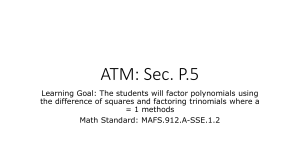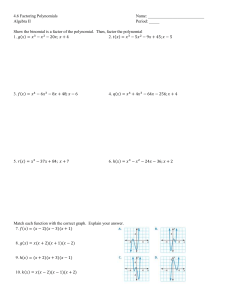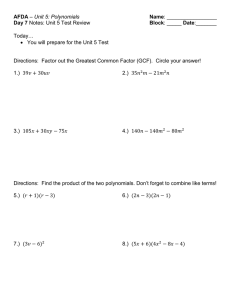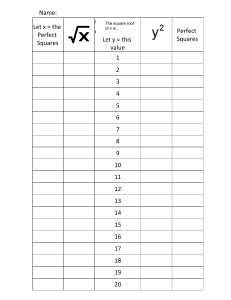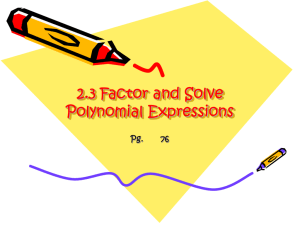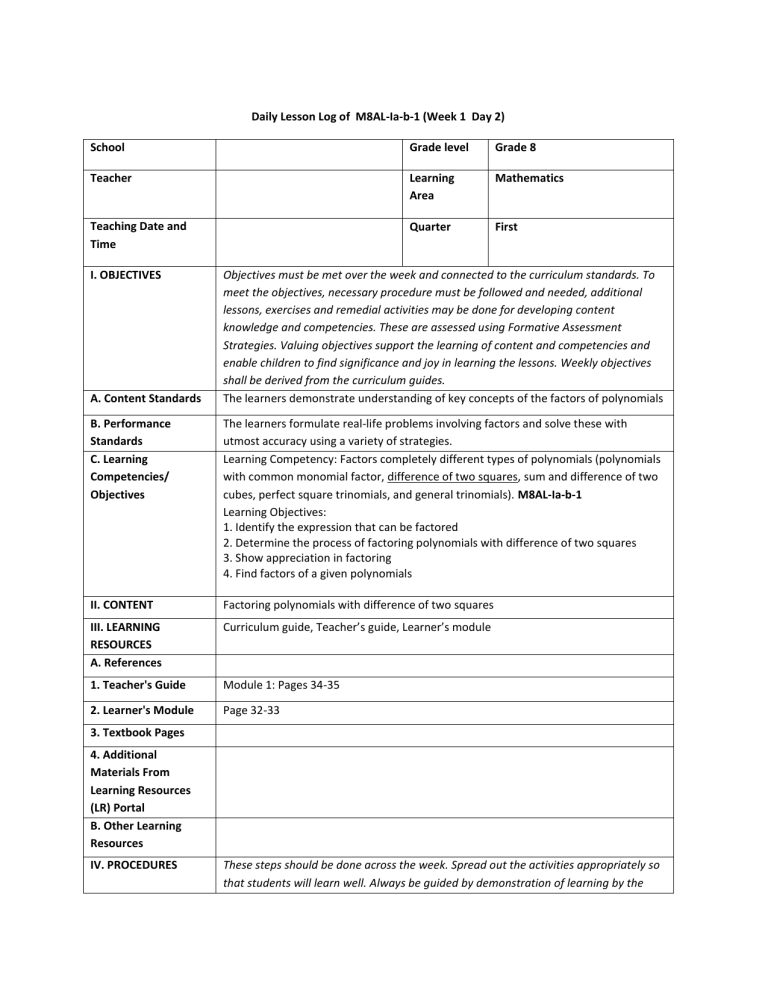
Daily Lesson Log of M8AL-Ia-b-1 (Week 1 Day 2) School Grade level Grade 8 Teacher Learning Area Mathematics Teaching Date and Time Quarter First I. OBJECTIVES A. Content Standards Objectives must be met over the week and connected to the curriculum standards. To meet the objectives, necessary procedure must be followed and needed, additional lessons, exercises and remedial activities may be done for developing content knowledge and competencies. These are assessed using Formative Assessment Strategies. Valuing objectives support the learning of content and competencies and enable children to find significance and joy in learning the lessons. Weekly objectives shall be derived from the curriculum guides. The learners demonstrate understanding of key concepts of the factors of polynomials B. Performance Standards C. Learning Competencies/ Objectives The learners formulate real-life problems involving factors and solve these with utmost accuracy using a variety of strategies. Learning Competency: Factors completely different types of polynomials (polynomials with common monomial factor, difference of two squares, sum and difference of two cubes, perfect square trinomials, and general trinomials). M8AL-Ia-b-1 Learning Objectives: 1. Identify the expression that can be factored 2. Determine the process of factoring polynomials with difference of two squares 3. Show appreciation in factoring 4. Find factors of a given polynomials II. CONTENT Factoring polynomials with difference of two squares III. LEARNING RESOURCES A. References Curriculum guide, Teacher’s guide, Learner’s module 1. Teacher's Guide Module 1: Pages 34-35 2. Learner's Module Page 32-33 3. Textbook Pages 4. Additional Materials From Learning Resources (LR) Portal B. Other Learning Resources IV. PROCEDURES These steps should be done across the week. Spread out the activities appropriately so that students will learn well. Always be guided by demonstration of learning by the A. Review previous lesson Or presenting the new lesson students which you can infer from formative assessment activities. Sustain learning systematically by providing students with multiple ways to learn new things, practice the learning, questions their learning processes, and draw conclusions about what they learned in relation to their life experiences and previous knowledge. Indicate the time allotment for each step. The teacher lets the students recall the definition of factoring and the first type of factoring introduced to them. Possible response: Factoring is the reverse of multiplication. The first type was factoring by greatest common monomial factor He/she then ask the students if the given polynomial below has a common monomial factor and let them also describe the given polynomial 1. abc + abd 2. 24m2-12m 3. X2-y2 4. 25-b2 Possible response: numbers 1 and 2 have a common monomial factor numbers 3 and 4 don’t have any common monomial factor The given polynomials are binomials terms in numbers 3 and 4 are perfect squares numbers 3 and 4 are polynomial with difference of two squares B. Establishing a purpose for the lesson C. Presenting examples/ instances of the new lesson The teacher lets the students realize that factoring by common monomial factor is not applicable to all polynomials but it is necessary that greatest common monomial factor should be use first before applying any type of factoring. The teacher lets the students , in group of two do the Activity 5 on page 32 of the Learner’s Module and answer the following questions: 1. How do you think the products are obtained? 2. What are the different techniques used to solve for the products? 3. What is the relationship of the product to its factor? 4. Have you seen any pattern in this activity? Possible responses : 1. D. Discussing new concepts and practicing new skills #1 E. Discussing new concepts and the product are obtain by making the given numbers into sum and difference of binomials 2. by multiplying the sum and difference of binomials 3. the factors of difference of two squares are sum and difference of binomials. 4. Students give varied answers The teacher discusses with students using the given number pattern of activity 5 to see the relationship of factors to product. He/she may bring back the students to multiplying sum and difference of binomials in special product to see how factors may be obtained. Students should realize that factors of difference of two squares are sum and difference of binomials. The teacher illustrate now on how to obtain the factors of polynomials with difference of two squares. He/she can use the examples found in learner’s module at page 33. practicing new skills #2 F. Developing mastery ( leads to formative assessment) The teacher lets the students match polynomials of column A to its corresponding factors in column B. 1. 2. 3. 4. 5. Column A X2-16 9-m2 X2-4 81-m2 x2- 9 Column B a. (9+m)(9-m) b. (x-3)(x+3) c. (x+4)(x-4) d. (3-m)(3+m) e. (x+2)(x-2) Answer key: 1. 2. 3. 4. 5. G. Finding practical applications of concepts and skills in daily living H. Making generalizations and abstractions about the lesson X2-16 9-m2 X2-4 81-m2 x2- 9 ------- c. (x+4)(x-4) ------- d. (3-m)(3+m) --------- e. (x+2)(x-2) -------- a. (9+m)(9-m) -------- b. (x-3)(x+3) The teacher summarizes the concept of factoring polynomials with difference of two squares by asking the following questions: 1. What are the factors of polynomials with difference of two squares? 2. How to find the factors of a given polynomial with difference of two squares? Answers shall be drawn from the students. Possible responses: 1. It is the sum and difference of binomials 2. Get the square roots of the two squares, then write the product of the sum and difference of the square roots Remember: The factored form of a polynomial that is a difference of two squares is the sum and difference of the square roots of the first and last terms. I. Evaluating Learning The teacher lets the students answer individually the formative assessment. Find the factors of the given polynomials. 1. c2-25 2. w4-1 3. 36-h6 4. k4-100 5. 1-r10 Answer key: 1. (c-5)(c+5) 2. (w2-1) (w2+1) 3. (6-h3) (6+h3) 4. (k2-10) (k2+10) 5. (1-r5) (1+r5) J. Additional Activities or Remediation V. REMARKS VI. REFLECTION A. No. Of learners who earned 80% of the evaluation B. No. Of learners who require additional activities for remediation who scored below 80% C. Did the remedial lesson work? No. Of learners who have caught up with the lesson D. No. Of learners who continue to require remwdiation E. Which of my teaching strategies worked well? Why did these work? F. What difficulties did I encounter which my principal or supervisor Can help me solve? G. What innovation or localized materials did I use / discover which I wish to share with other teachers The teacher may let the students answer Activity 7 on page 34 of the Learner’s Module to enhance more their skills in factoring polynomials with difference of two squares. Prepared by: ABIGAIL Y. MUÑEZ Labogon NHS


